
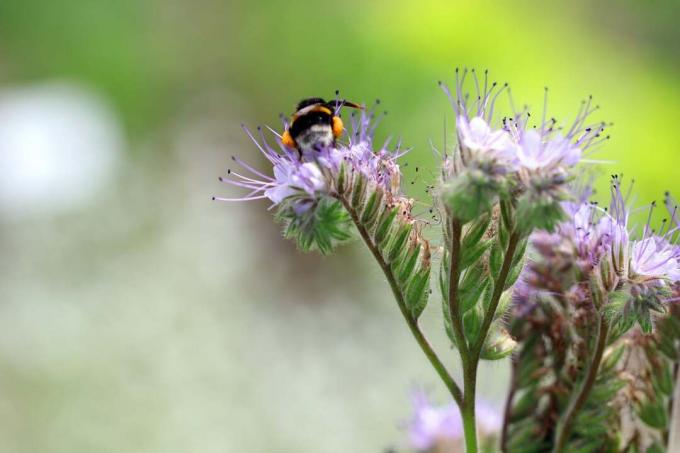
Table of contents
- Characteristics
- Observe location tolerance
- Carry out sowing correctly
- Select plant neighbors
- Water only occasionally
- Don't fertilize excessively
- Refrain from cutting
- collect seeds
- protection against diseases
Phacelia tanacetifolia has been cultivated since 1832, primarily for the benefit of beekeeping. Due to the high nectar production, the species is also known as the honey plant.
Characteristics
- Genus Phacelia contains about 150 species
- belongs to the borage family
- Phacelia tanacetifolia is suitable for cultivation in Central Europe
- develops wheel-shaped and blue to violet colored flowers in zymose inflorescences
- Flowering time is between June and October
- is used as an ornamental and useful plant for bee pastures, as a forage plant or for green manure
Observe location tolerance
Originally, the phacelia comes from the New World. Their range extends across Mexico, California and Arizona. Stony rocky slopes represent the natural habitat, whereby the tufted flower can also be found growing wild on roadsides and roadsides or on rubble heaps and fields. It can be found up to an altitude of 2,000 meters. Your requirements for location and soil are accordingly simple:
- prefers sunny to semi-shady locations
- grows on all soils that are permeable
- thrives in humus-rich or lean, stony and sandy substrates
- tolerates dry conditions
Carry out sowing correctly

The phacelia belongs to the dark germs. Since their seeds are sensitive to frost, sowing is only recommended in mild temperatures. You should therefore keep an eye on the climate in your region when sowing. The seed is sown in the bed as follows:
- Direct sowing takes place from April to September
- ideally wait until the ice saints are over
- Sowing in planters possible from March
- Sow seeds in rows 15 centimeters apart and cover thinly with soil
- Widespread spreading is also possible on large areas
- Then gently roll or press down the substrate
- apply a new portion of seeds every two to three weeks to prolong the flowering period
Tip:
If you then keep the bed evenly moist and the temperature is between twelve and 18 degrees, the seeds will germinate within ten to 14 days.
Select plant neighbors
Phacelia tanacetifolia reaches heights of 20 to 120 centimeters. With its short-haired stems topped with spreading leaves, the plant blends into beds with wild perennials and flowers. It is suitable for natural gardens and increases the variety of insects. Species that are equally valuable for the garden fauna and have similar demands on the location are suitable as planting partners:
- valuable bee plants: buckwheat, marigold, borage and black cumin
- herbs suitable for cooking: wild carrot, fennel, burnet, parsnip and hornbeam clover
- clover-like legumes: Swedish clover, Alexandrian clover, crimson clover, Persian clover and yellow clover
Water only occasionally
The plant is adapted to habitats where the subsoil holds little or no water. Their tolerance to drought is correspondingly high. Normally, the natural rainy periods are sufficient to supply the Facellia with sufficient water. Additional watering makes sense in these situations:
- Regular watering makes sense in the initial phase so that the substrate remains evenly moist
- Outdoor plants are happy to be watered in the morning or evening during hot periods
- Water potted plants when the soil has dried out
Don't fertilize excessively
The bee friend develops a dense and richly branched root system. This enables the plant to make optimal use of the nutrients in the soil, even if it is characterized by lean properties. Due to this good survivability, it is not necessary to additionally fertilize the bed. If the insect magnets thrive on normal garden soil, fertilization is unnecessary. If poor soil or sandy substrates are available, the nutrients of which are quickly used up, a nutrient supply makes sense. It helps maintain flowering propensity and causes increased leaf mass development. How to do it right:
- Fertilize outdoor plants showing signs of deficiency and potted plants
- perform once a month after the first pair of leaves has developed
- Use liquid fertilizer in low concentration
Refrain from cutting
Facilia is a green manure plant whose aerial parts die off in autumn. As soon as the thermometer falls into the minus range, the tufted flower has no chance of surviving. Pruning measures are just as unnecessary as cleaning up the bed. As leaves and stems rot, they release their stored nutrients into the soil. Since the bee friend increases the humus content of the soil, its productivity increases. The roots improve the soil structure, resulting in a long-term increase in yield security, even on light soil.
Tip:
Leave the plants after they wither and dig up the soil next spring. The stored nutrients ensure a natural source of nutrients and provide improved growth conditions for subsequent seeds.

collect seeds
The tufted beauty is a magnet for bumblebees, honey and wild bees as well as butterflies and hoverflies. They feed on the nectar and pollen and provide fertilization during the flowering period in summer. Once this has taken place, the plant produces two-column capsule fruits. The seeds contained therein are reminiscent of small oranges due to their warty surface. They are very light and spread with the wind. In order to propagate the one-year-old Tuftsweet manually from its seeds, speed is required:
- Cut off the infructescences just before they are fully ripe.
- the ideal time has come when the fruit has not dried through and is completely closed
- Bundle plant parts and hang upside down in a well-ventilated room to dry
- Empty the slightly bursting fruit capsules into a clean pickle jar
- keep dark and dry until next spring
Tip:
You can store the seeds for about four to five years without losing their ability to germinate.
protection against diseases
The phacelia proves itself resistant to diseases and harmful insects. It is not closely related to typical useful plants in the home garden. For this reason, you do not have to fear any pathogens or pests that can be transmitted from the honey plant to other species. It protects reseeding from rootlets or clubroot.
 garden editorial
garden editorial I write about everything that interests me in my garden.
Learn more about summer flowers
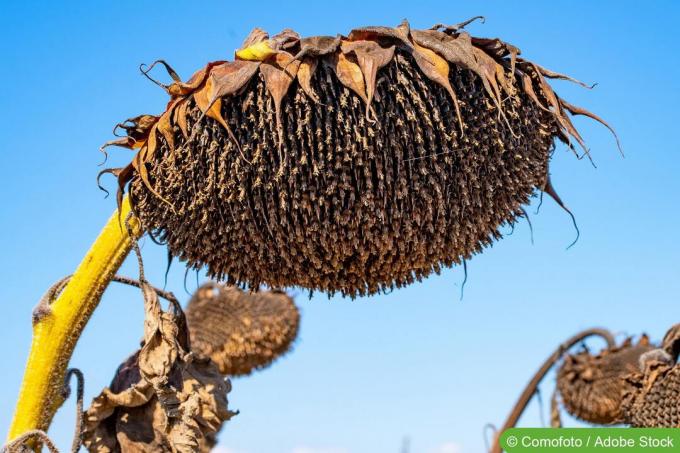
Should you cut off faded sunflowers?
Sunflowers bloom for a long time, but unfortunately not forever. Is it better to cut off the faded flowers or let nature take its course? Both are possible! It depends on the sunflower species and what you want to do with the ripening seeds. Read here whether you should cut off faded sunflowers.
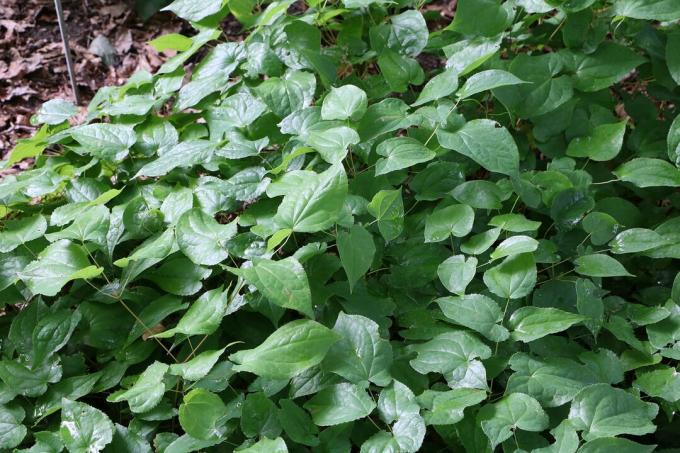
Elf Flower, Epimedium: 12 Tips for Grooming & Pruning
The elf flower transforms shady locations into a sea of flowers. Delicate flowers appear in white, yellow, pink, red or violet. The ground cover with the heart-shaped leaves is also decorative when not in bloom. We have put together the most important care tips for you.

Liver Balm, Ageratum: 10 tips for care
The leather balm is a daisy family that comes from Central and South America. In our latitudes, liver balm has been very popular for a long time, because here the plant does the trick not only a great figure as a gap filler between different perennials, but also in the form of one carpet of flowers.
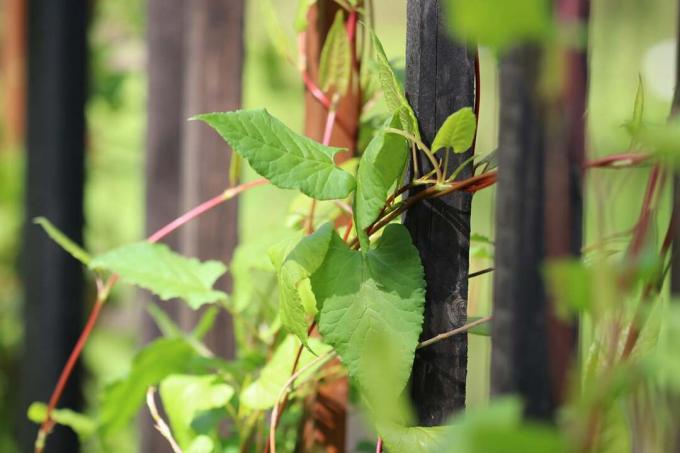
Climbing knotweed, Fallopia baldschuanica: Care from A – Z
A popular bee pasture but also a fast-climbing plant in the garden is the climbing knotweed. The plant should therefore be cultivated in the garden with some caution and appropriate care. Fallopia aubertii fits perfectly in a cottage or natural garden.
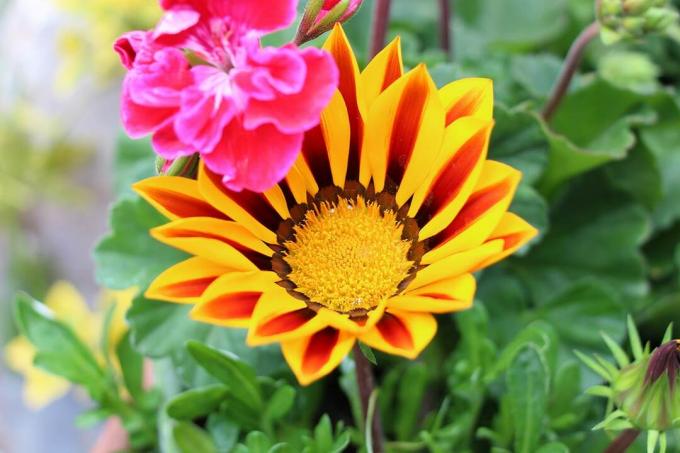
Is Gazania hardy? 6 tips for the winter
Gazania are commercially offered as annuals and not hardy. Hibernation works under ideal conditions, which require increased effort. Some varieties are considered hardy. The propagation of cuttings over the winter is an alternative to cultivating the plant perennial.

Loyal to men, lobelia: care instructions from A – Z
Loyal to men, also known as blue lobelia, flowers profusely all summer long with the right care. This beautiful bloom is encouraged by the right care. The blaze of color is not only beautiful to look at, the lobelia are also popular with various insects.



